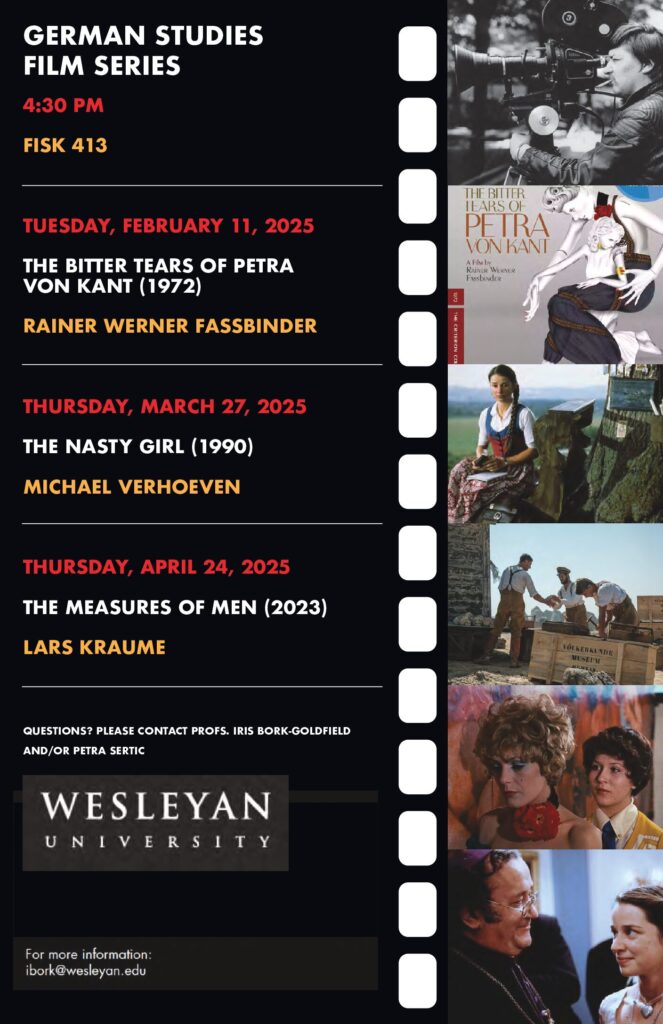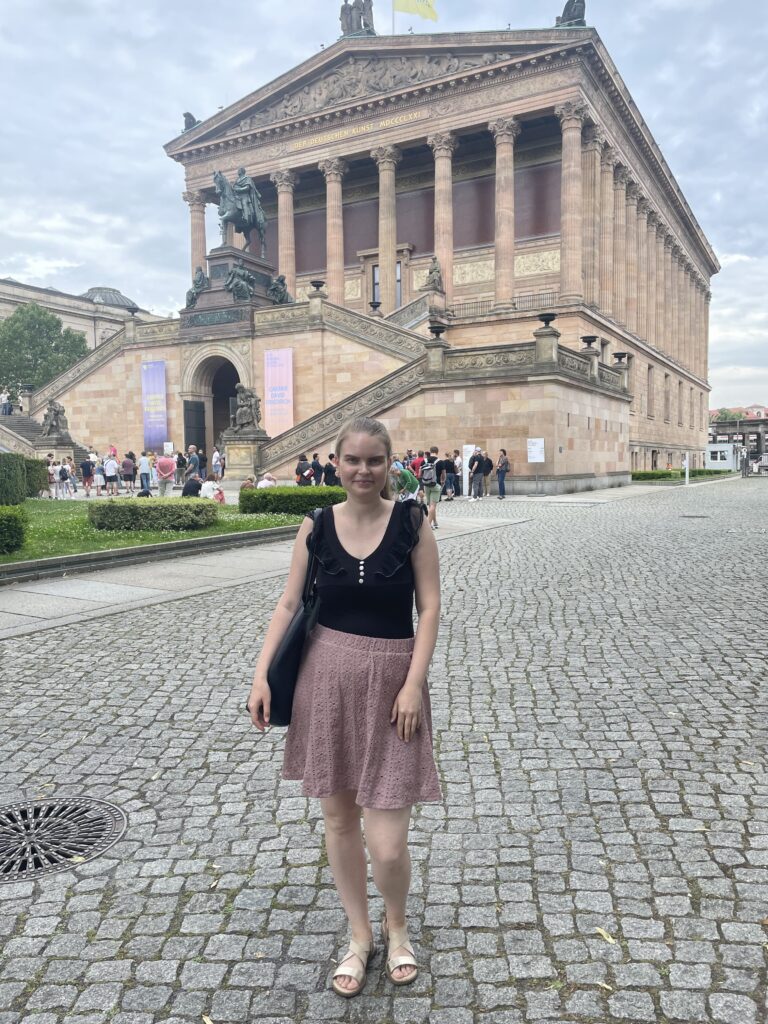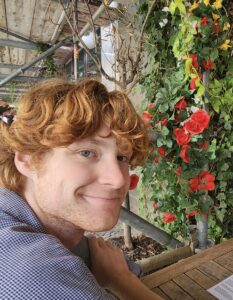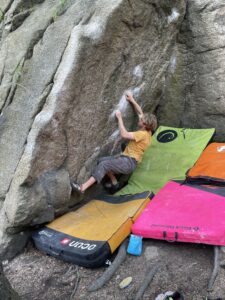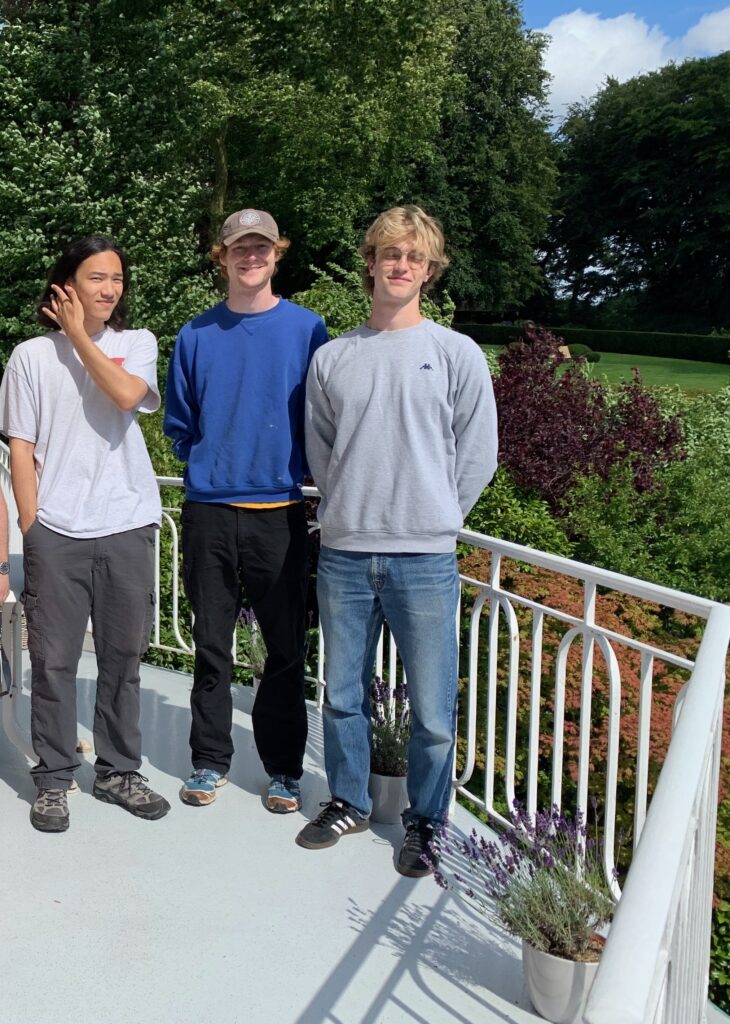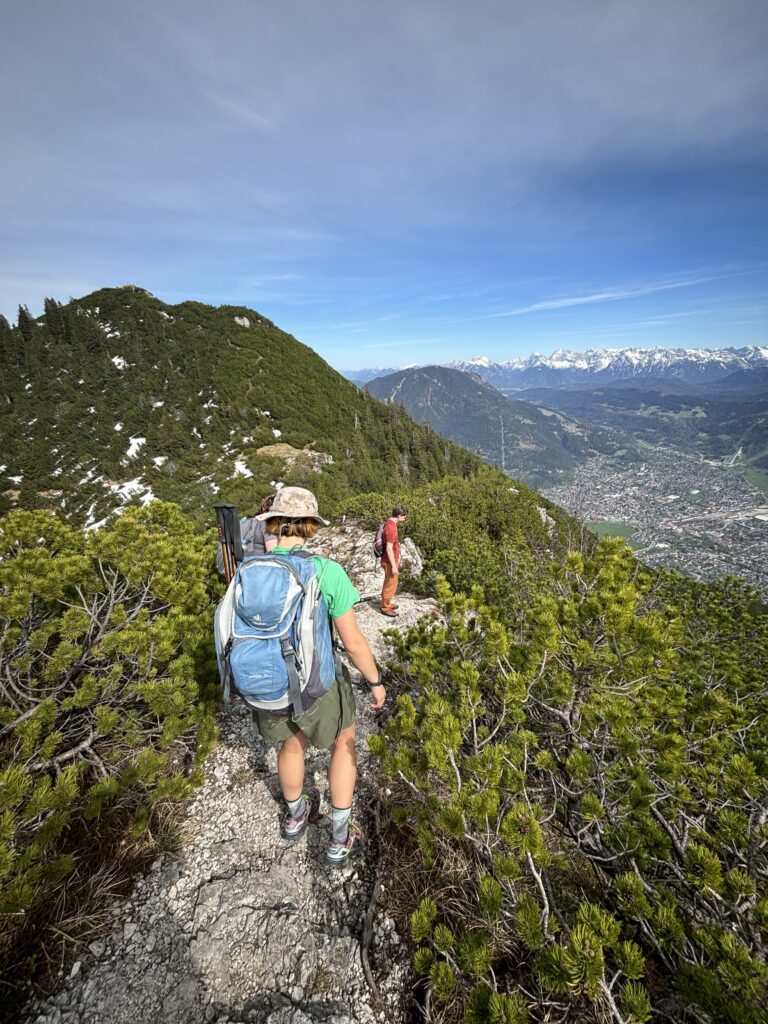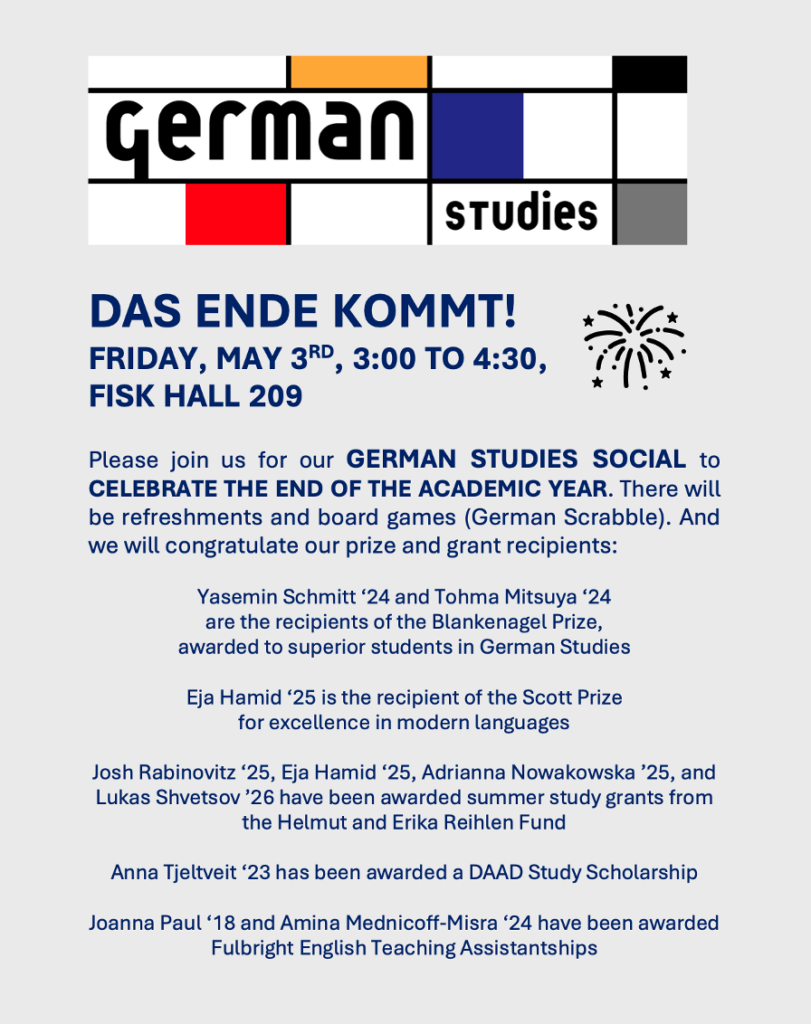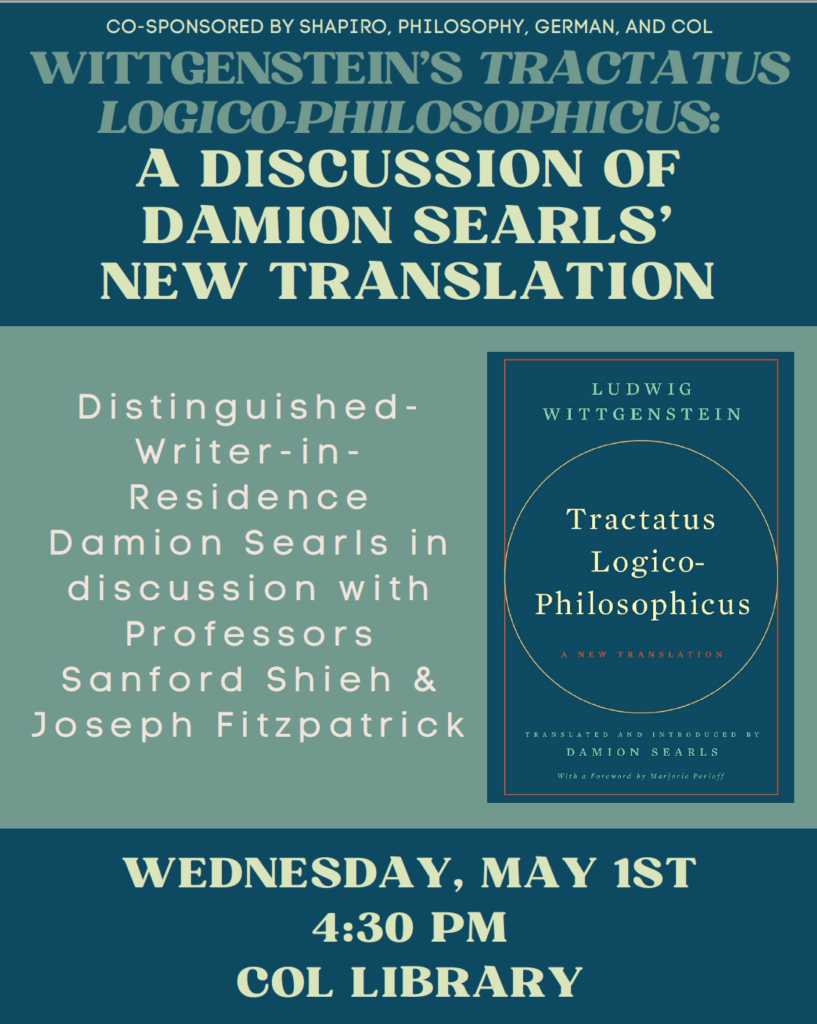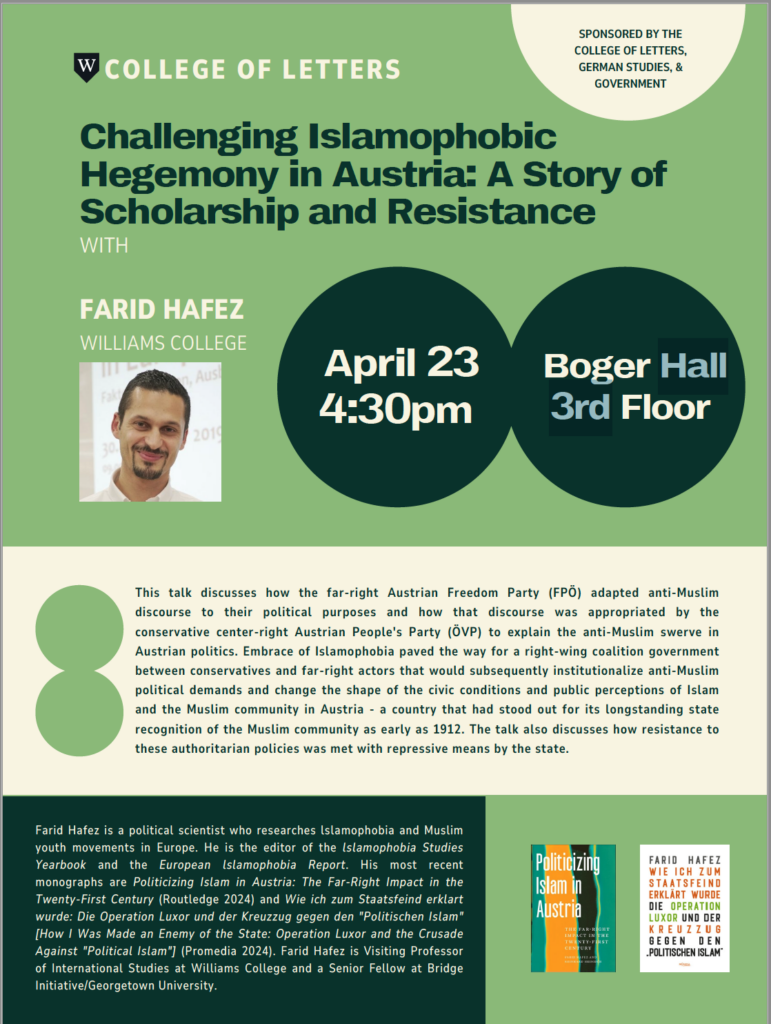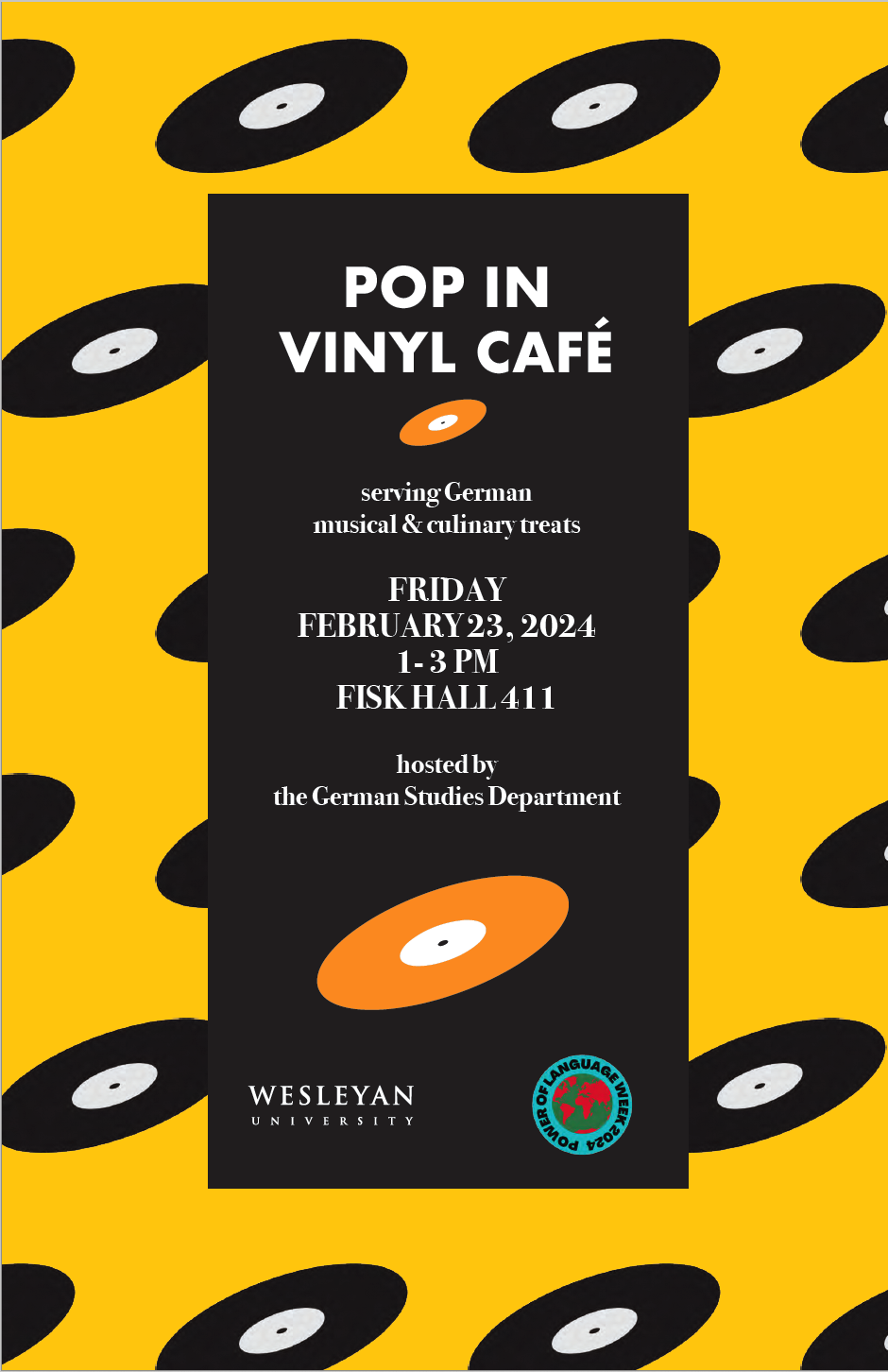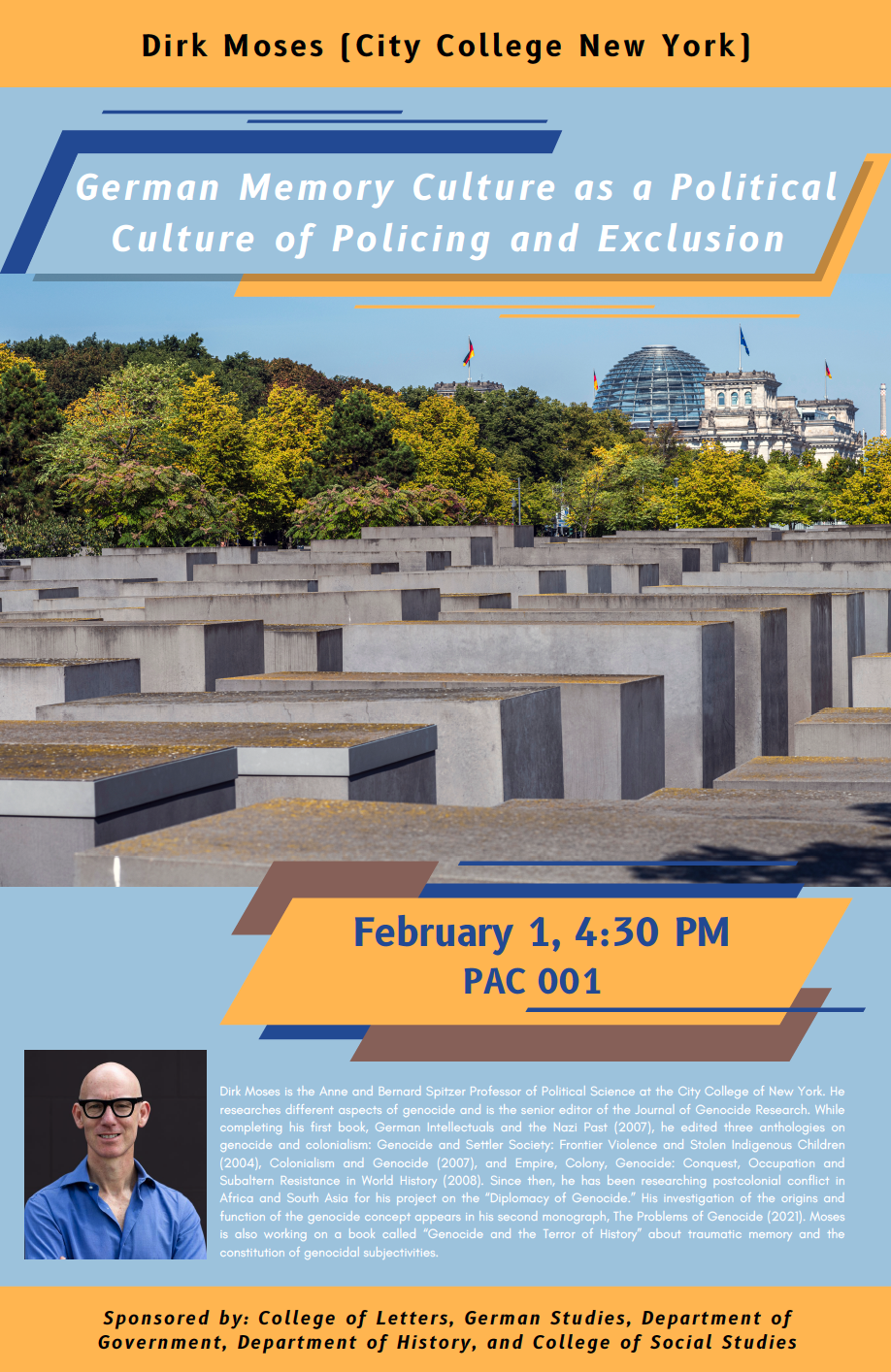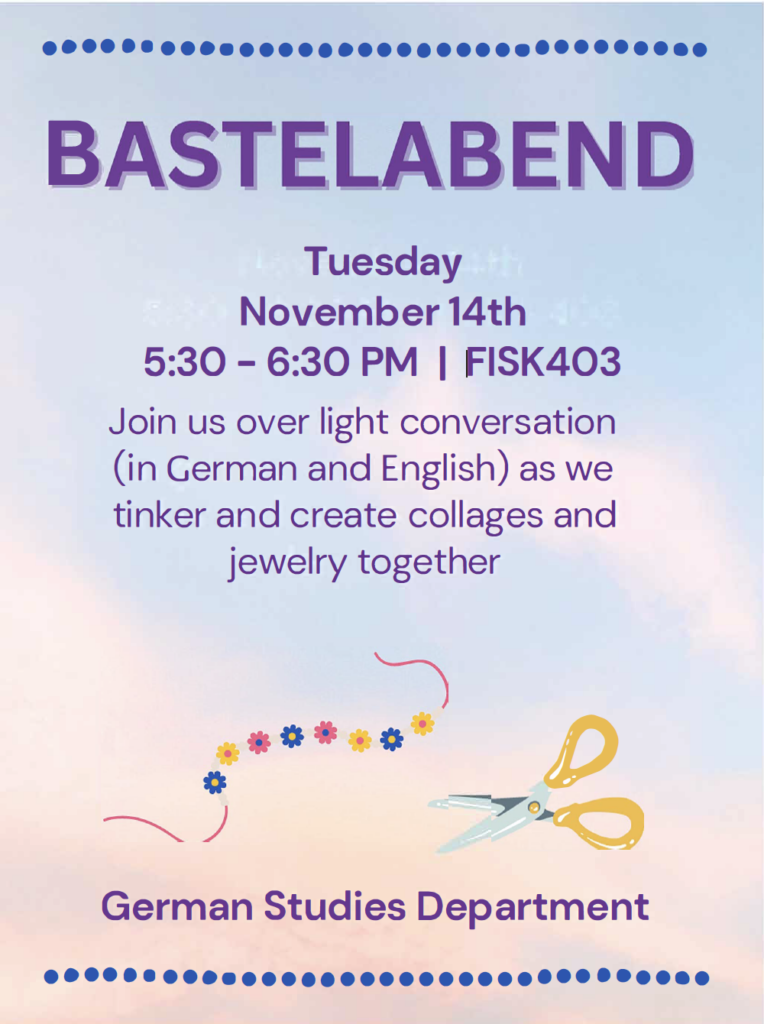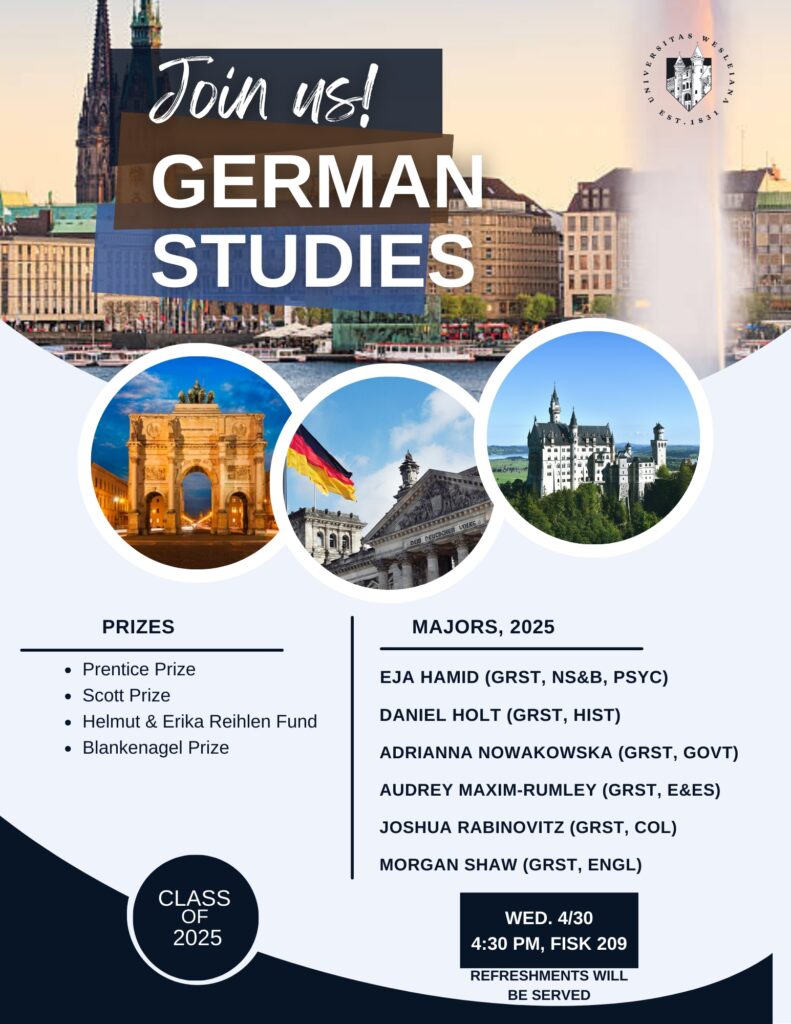
 Iris Bork-Goldfield
Iris Bork-Goldfield
German Conversation

Please contact Eja Hamid if you have any questions.
Living and Working in Hamburg, Germany
Isaac Ostrow’26, became the first Wesleyan student to attend the Smith in Hamburg Practicum Program with his participation this last fall. He interned at the Hamburg Institut, which offers counseling and research in questions of energy transition.
A Semester Abroad 2024
Last semester, several of our students spent one semester in Germany. German universities operate on winter-summer semesters. I asked them to send me some information about their life and studies in Germany.
Adriana Nowakoswska ‘25
Ada was on an exchange program with the Berlin Consortium for German Studies, taking fully integrated courses about European Union politics with the local students at Freie Universität. She caught an important parliamentary session in the Bundestag, attended the Walter Benjamin lectures, and listened to Axel Honneth discuss the future of labor at a philosophy festival. She also enjoyed the amazing cultural scene that Berlin has to offer — the independent cinemas in Hackeschen Höfe, an acclaimed Caspar David Friedrich exhibition at the Alte Nationalgalerie, and an international theater festival at the Schaubühne, among others. Simultaneously, she used the proximity of Berlin to her home, Poland, to start the groundwork for her senior capstone project in Government about the politicization of education reform under the most recent former education minister, Przemysław Czarnek. Ada interned at the Polnischer Sozialrat, a foundation that counsels Polish immigrants in Berlin/Germany in areas such as social aid, worker rights, healthcare or the legal system. She writes about her time in Berlin: “Overall, my time in Berlin has been incredibly academically and personally enriching, allowing me to prepare for my chosen political science master’s programs in Europe. At first, I found the switch from ‘classroom’ to ‘real life’ German a bit difficult and disorienting, but quickly I realized that even if I didn’t understand every word spoken, I drew immense benefits from immersing myself in the language and the city in this way. I am beyond grateful to the German Department for the Reihlen Fund, which allowed me to take up my unpaid internship position and take advantage of Berlin’s academic and cultural opportunities to the fullest.”
Morgan Shaw ’25
Morgan studied with the Smith in Hamburg program at the university of Hamburg, Germany. He took a class on the history of German literature from 1600 to the present and a course on the history of Germany since 1945. The literature class offered cohesive insights into a field he had only been able to dip into sporadically at Wesleyan. He finished the semester by researching Trümmerliteratur (rubble literature), which was produced right after the end of the Second World War. This activity—Morgan explained—”worked satisfyingly in tandem with the history class, which gave a great look at how the development of Germany after the Second World War influenced and was influenced by American culture and global politics.”
While in Germany, he took ample advantage of the great outdoors, which is available—for the most part—by a short train trip. Morgan especially enjoyed hiking and rock climbing in the Harz mountains in central Germany with Daniel Holt, another German Studies major! Morgan is looking forward to returning to Wesleyan and continuing his work with the German department in Herr Plass’ class on the Weimar Republic. “As much as I have loved my time in Hamburg—and it really has been amazing!—I am looking forward to getting back to Wesleyan and finishing up my senior year.”
Daniel Holt ‘25
Daniel also spent his semester abroad with the Smith program at the University of Hamburg, where he arrived in February. During his semester in Hamburg, he fully immersed himself in German language and culture. He took three courses in German at the University of Hamburg and one course in English on “Colonialism and Politics in East Africa”. His language skills—Daniel tells me— “have definitely improved,” not only because of his classes at the University, but also because of the unique living arrangements. He was lucky enough to be placed in a dormitory which was comprised of mostly German students, and even the other few international students all spoke German.
Cultural immersion was also an important part of building on language skills. Daniel wrote, “whether my friends and I were playing pool at the local billiards bar, pub-crawling through the many Kneipen (pubs) in the Sternschanze or Reeperbahn, or getting past the scrutinous eye of the bouncer at the Feldstraße bunker-raves, the raw nightlife of Hamburg was always booming. During the day, and especially as the weather got better later in the year, we would kayak through the canals and waterways of the Alster which crisscrossed down from the North until emptying into the Elbe River. Towards the end of my semester, I received a grant from The Helmut and Erika Reihlen Fund for German Studies, for which I would like to thank Iris Bork-Goldfield, Ulrich Plass, and Martin Bäumel for their support and guidance. With the assistance of the Wesleyan German department, I was able to visit cultural and ethnological museums in both Berlin and Hamburg, as well as the Staatsarchiv in Berlin which houses archival documents from the German Imperial Colonial Office. These museums and collections were abundant with information about German colonialism, which will be a central theme of my thesis as I prepare for my senior year at Wesleyan. Not only did this grant help me raise new questions about my prospective thesis work, as well as decipher some others; it allowed me to experience the painstaking yet valuable skill of archival work for the first time.”
Josh Rabinovitz ‘25
Josh, like Morgan and Daniel, studied in Hamburg. He describes his experience in Hamburg as exciting! It was his first time in Germany and Europe, and it was “very welcoming.” Apart from taking classes at Hamburg University, he spent the semester exploring nature and music around Hamburg, traveling through Germany, and improving his German skills. After classes ended, Josh spent time in Germany researching for his thesis (in COL and GRST), financed by the Helmut and Erika Reihlen grant. The rest of the summer, Josh worked in the US at the American Academy of Poets.
The Smith in Hamburg program is a Wesleyan-approved program and also offers internships during the fall semester.
Audrey Maxim-Rumley ‘25
Audrey studied in Munich, Germany, with the Junior Year in Munich program hosted by Wayne State University. When asked why she chose this program, she replied: “I chose the program because I wanted to participate in an internship in the German-speaking world, and I achieved that by earning a position at Netzwerk Klimaherbst e.V., where I got to work with three wonderful co-workers supporting sustainability and climate protection initiatives around the city. My internship was one of the highlights of my semester, along with a class at the Ludwig-Maximilians-Universität titled Klasse, Familie, Nation – Herkunft erzählen 1970 und heute, which included reading books by authors such as Peter Handke and Saša Stanišić.” Audrey also spent many hours exploring Olympiapark, adjacent to where she lived, along with riding her bike all over Bavaria and hiking in the Alps.
Joanna Paul’18 received a Fulbright ETA scholarship
Joanna Paul graduated from Wesleyan in 2018 with a BA in psychology and sociology and a German minor! During her sophomore year in 2016 she had the opportunity to study abroad in Germany for six months with Duke in Berlin and it was the best time of her life!
Joanna will be graduating from an MPH/MSW dual degree program in Chicago this May and just accepted an award for a Fulbright English Teaching Assistantship in Hessen, Germany for ’24-’25. Joanna is thrilled about the opportunity to return to Germany after all these years to reconnect with her host families/exchange students from high school and college, as well as to improve her German skills and volunteer in her free time.
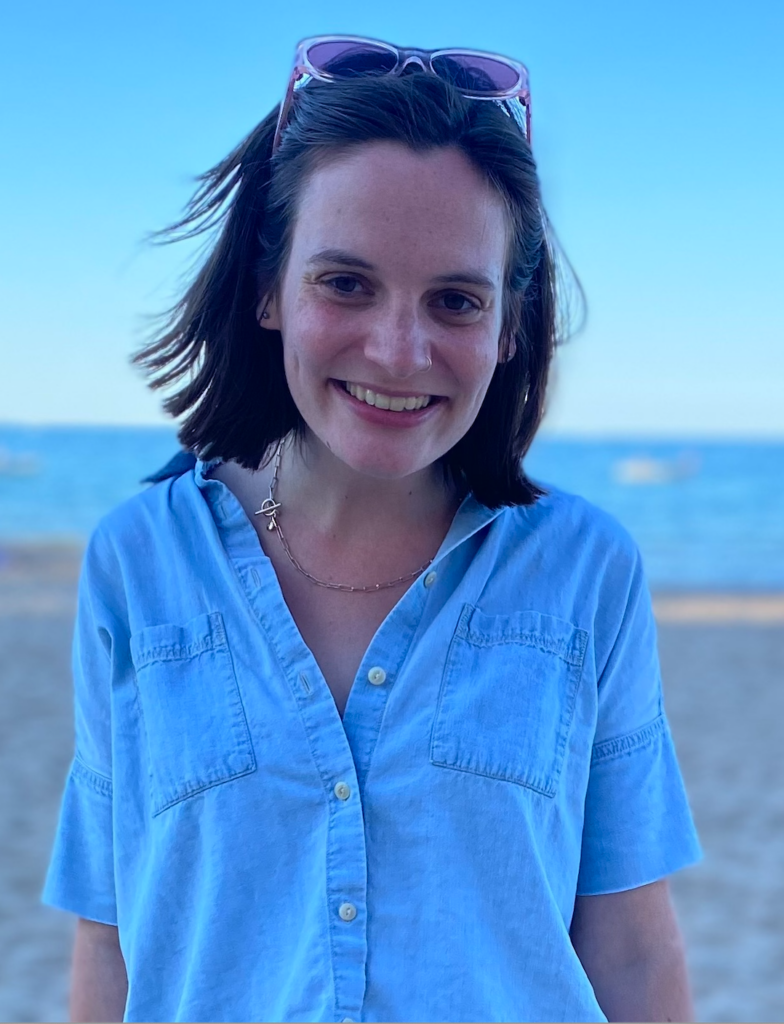
Bach Konzert
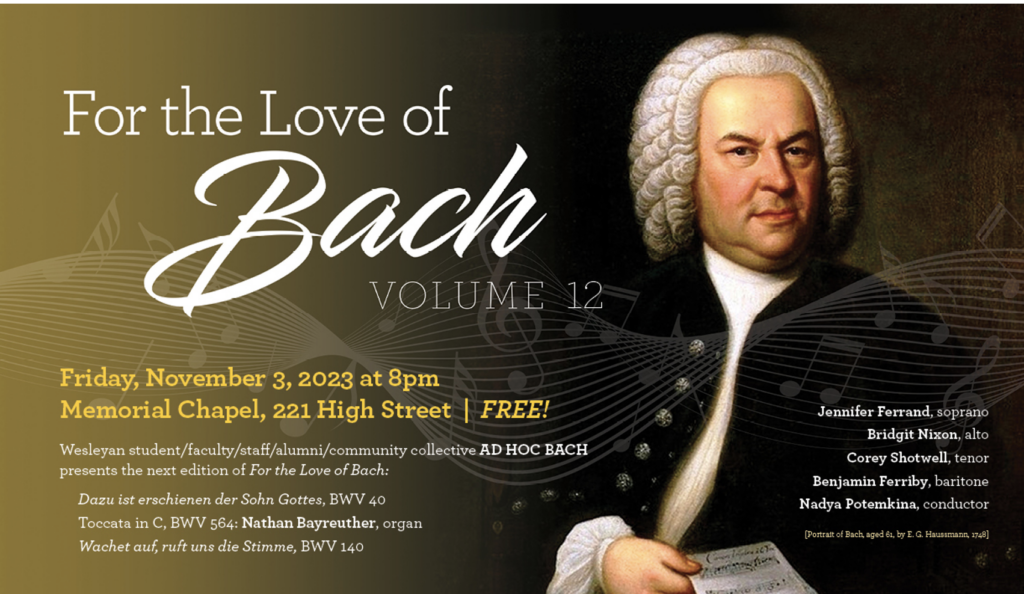
It’s free and all are welcome.
The Details:
– The concert is in the Memorial Chapel (221 High St., Middletown).
– It begins at 8:00 p.m. on Friday, Mar 3 and lasts about an hour.
– The concert is presented free of charge.
The Program:
Dazu ist erschienen der Sohn Gottes, BWV 40
Toccata in C, BWV 564
Wachet auf, ruft uns die Stimme, BWV 140
Ad Hoc Bach Chorus and Orchestra
Nadya Potemkina, Music Director and Conductor




